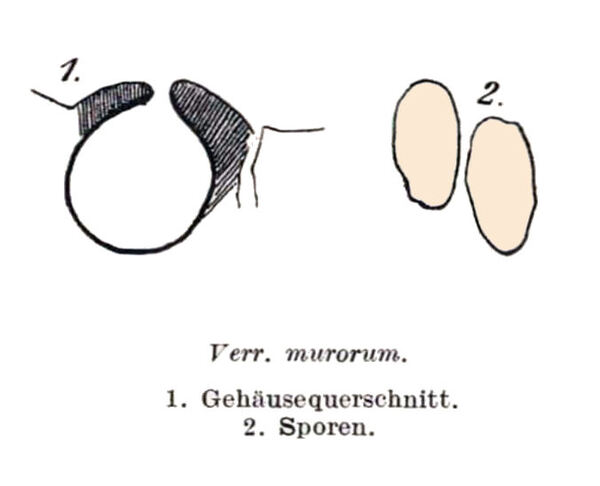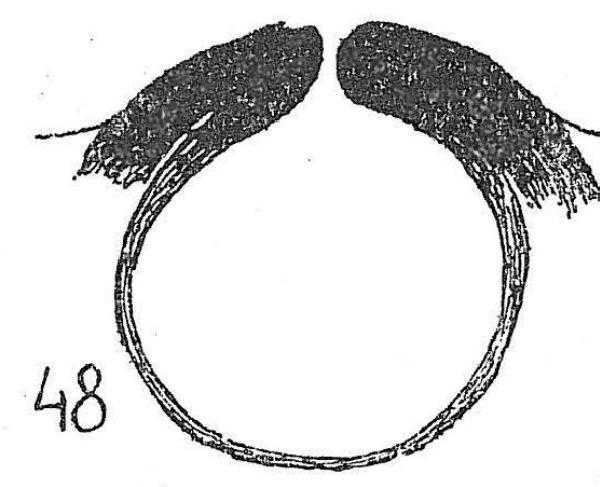Verrucaria murorum (Arnold) Lindau
Die Flecht.: 5, 1913. Basionym: Lithoicea murorum Arnold - Flora, 43, 5: 75, 1860
Synonyms: Thrombium murorum A. Massal., nom. inval.
Distribution: N - Ven (Lazzarin 2000b), TAA, Lomb, Emil, Lig. C - Tosc, Sar. S - Camp, Pugl, Bas (TSB 21992), Si.
Description: Thallus crustose, episubstratic, rimose-areolate, 0.3-0.5(-0.8) mm thick, grey-brown to dark brown, sometimes delimited by a thin, dark prothallus, forming extensive patches, the areoles small, 0.3-1(-1.5) mm wide, markedly uneven, often subdivided into even smaller units, separated by thin fissures. Cortex poorly developed or to 30 μm thick, overlain by a very thin epinecral layer; algal layer 100-200 μm thick; medulla white or brownish, of irregular thickness, without a black basal layer, Perithecia black, the apical part up to 0.7 mm across, naked, slightly projecting. Involucrellum hemispherical, reaching down ⅓–⅔ of the perithecium, loosely adpressed to exciple, 70-120 μm thick in upper part, c. 150 μm thick at base; exciple subglobose, 0.4-0.6 mm across, the wall colourless to brown, 20-30 μm thick; hamathecium of branched and anastomosing, 40-65(-70) μm long periphyses and periphysoids, interascal filaments absent; hymenial gel hemiamyloid, I+ red (I+ blue at very low concentrations of I), K/I+ blue. Asci 8-spored, clavate, I-, fissitunicate, the wall thickened above, with an ocular chamber, dehiscent by extrusion of an endotunica to form a delicate rostrum, Verrucaria-type. Ascospores 1-celled, hyaline, broadly ellipsoid, 24-35 x 13-16(-17) μm. Photobiont chlorococcoid. Spot tests: K-, C-, KC-, P-, UV-. Chemistry: without lichen substances.Note: a rather poorly known species of calcareous rocks, belonging to the V. macrostoma-complex. For a detailed description see Breuss (2008).
Growth form: Crustose
Substrata: rocks
Photobiont: green algae other than Trentepohlia
Reproductive strategy: mainly sexual
Poorly known taxon in need of further study
Commonnes-rarity: (info)
Alpine belt: absent
Subalpine belt: extremely rare
Oromediterranean belt: absent
Montane belt: very rare
Submediterranean belt: rare
Padanian area: very rare
Humid submediterranean belt: rare
Humid mediterranean belt: very rare
Dry mediterranean belt: very rare
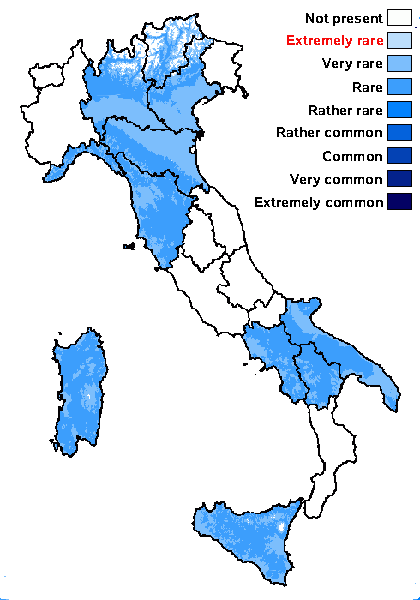
Predictive model
Herbarium samples
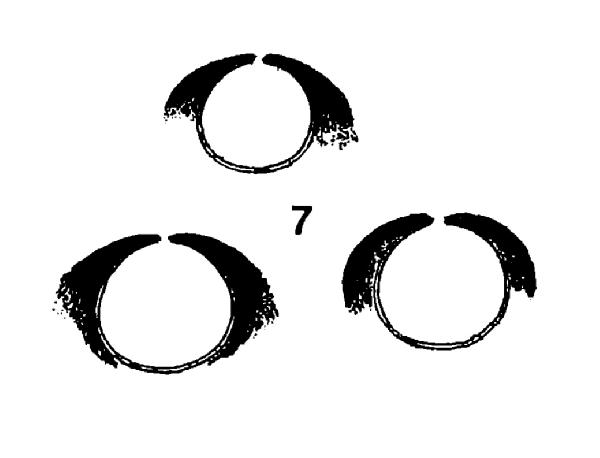
Source: Breuss O. 2008b. Bemerkungen zu einiger Arten der Flechtengattung Verrucaria. Sauteria, 15: 121-138. Author: Othmar Breuss
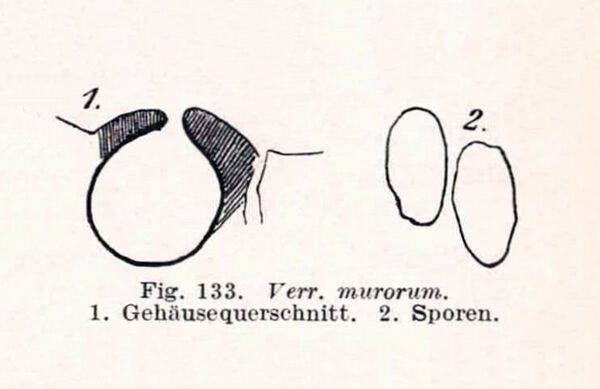
Zschacke, H. (1934) Epigloeaceae, Verrucariaceae und Dermatocarpaceae. In: Dr. L. Rabenhorst‘s Kryptogamen-Flora, Band 9, Abt. 1, Teil 1. Akademische Verlagsgesellschaft, Leipzig, 695 pp. - Public Domain
Growth form: Crustose
Substrata: rocks
Photobiont: green algae other than Trentepohlia
Reproductive strategy: mainly sexual
Poorly known taxon in need of further study
Commonnes-rarity: (info)
Alpine belt: absent
Subalpine belt: extremely rare
Oromediterranean belt: absent
Montane belt: very rare
Submediterranean belt: rare
Padanian area: very rare
Humid submediterranean belt: rare
Humid mediterranean belt: very rare
Dry mediterranean belt: very rare

Predictive model
| Herbarium samples |

Source: Breuss O. 2008b. Bemerkungen zu einiger Arten der Flechtengattung Verrucaria. Sauteria, 15: 121-138. Author: Othmar Breuss

 Index Fungorum
Index Fungorum
 GBIF
GBIF
